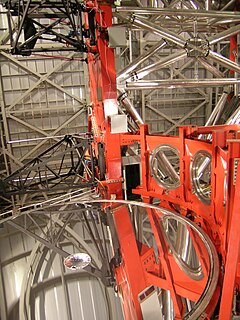
Amateur telescope making is the activity of building telescopes as a hobby, as opposed to being a paid professional. Amateur telescope makers build their instruments for personal enjoyment of a technical challenge, as a way to obtain an inexpensive or personally customized telescope, or as a research tool in the field of astronomy. Amateur telescope makers are usually a sub-group in the field of amateur astronomy.

Binoculars or field glasses are two refracting telescopes mounted side-by-side and aligned to point in the same direction, allowing the viewer to use both eyes when viewing distant objects. Most binoculars are sized to be held using both hands, although sizes vary widely from opera glasses to large pedestal-mounted military models.

The Large Binocular Telescope (LBT) is an optical telescope for astronomy located on 10,700-foot (3,300 m) Mount Graham, in the Pinaleno Mountains of southeastern Arizona, United States. It is a part of the Mount Graham International Observatory.

The W. M. Keck Observatory is a two-telescope astronomical observatory at an elevation of 4,145 meters (13,600 ft) near the summit of Mauna Kea in the U.S. state of Hawaii. Both telescopes have 10 m (33 ft) aperture primary mirrors, and when completed in 1993 and 1996 were the largest astronomical telescopes in the world. They are currently the 3rd and 4th largest.

A Ritchey–Chrétien telescope is a specialized variant of the Cassegrain telescope that has a hyperbolic primary mirror and a hyperbolic secondary mirror designed to eliminate off-axis optical errors (coma). The RCT has a wider field of view free of optical errors compared to a more traditional reflecting telescope configuration. Since the mid 20th century, a majority of large professional research telescopes have been Ritchey–Chrétien configurations; some well-known examples are the Hubble Space Telescope, the Keck telescopes and the ESO Very Large Telescope.
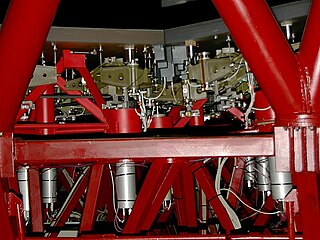
Active optics is a technology used with reflecting telescopes developed in the 1980s, which actively shapes a telescope's mirrors to prevent deformation due to external influences such as wind, temperature, mechanical stress. Without active optics, the construction of 8 metre class telescopes is not possible, nor would telescopes with segmented mirrors be feasible.

A reflecting telescope is a telescope that uses a single or a combination of curved mirrors that reflect light and form an image. The reflecting telescope was invented in the 17th century by Isaac Newton as an alternative to the refracting telescope which, at that time, was a design that suffered from severe chromatic aberration. Although reflecting telescopes produce other types of optical aberrations, it is a design that allows for very large diameter objectives. Almost all of the major telescopes used in astronomy research are reflectors. Reflecting telescopes come in many design variations and may employ extra optical elements to improve image quality or place the image in a mechanically advantageous position. Since reflecting telescopes use mirrors, the design is sometimes referred to as a catoptric telescope.
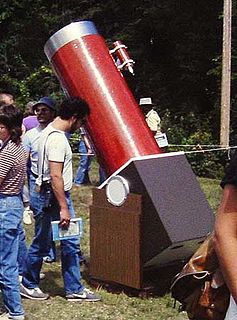
A Dobsonian telescope is an altazimuth-mounted Newtonian telescope design popularized by John Dobson in 1965 and credited with vastly increasing the size of telescopes available to amateur astronomers. Dobson's telescopes featured a simplified mechanical design that was easy to manufacture from readily available components to create a large, portable, low-cost telescope. The design is optimized for observing faint, deep-sky objects such as nebulae and galaxies. This type of observation requires a large objective diameter of relatively short focal length and portability for travel to less light-polluted locations.
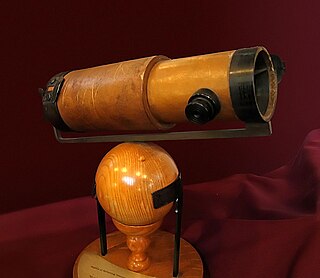
The Newtonian telescope, also called the Newtonian reflector or just the Newtonian, is a type of reflecting telescope invented by the English scientist Sir Isaac Newton (1642–1727), using a concave primary mirror and a flat diagonal secondary mirror. Newton's first reflecting telescope was completed in 1668 and is the earliest known functional reflecting telescope. The Newtonian telescope's simple design has made it very popular with amateur telescope makers.

The Hale Telescope is a 200-inch (5.1 m), f/3.3 reflecting telescope at the Palomar Observatory in San Diego County, California, US, named after astronomer George Ellery Hale. With funding from the Rockefeller Foundation in 1928, he orchestrated the planning, design, and construction of the observatory, but with the project ending up taking 20 years he did not live to see its commissioning. The Hale was groundbreaking for its time, with double the diameter of the second-largest telescope, and pioneered many new technologies in telescope mount design and in the design and fabrication of its large aluminum coated "honeycomb" low thermal expansion Pyrex mirror. It was completed in 1949 and is still in active use.
Russell Williams Porter was an American artist, engineer, amateur astronomer and Arctic explorer. He was a pioneer in the field of “cutaway illustration" and is sometimes referred to as the "founder" or one of the "founders" of amateur telescope making."

A Schmidt camera, also referred to as the Schmidt telescope, is a catadioptric astrophotographic telescope designed to provide wide fields of view with limited aberrations. The design was invented by Bernhard Schmidt in 1930.

The Extremely Large Telescope (ELT) is an astronomical observatory currently under construction. When completed, it is planned to be the world's largest optical/near-infrared extremely large telescope. Part of the European Southern Observatory (ESO) agency, it is located on top of Cerro Armazones in the Atacama Desert of northern Chile.

The 1.8 meter Alice P. Lennon Telescope and its Thomas J. Bannan Astrophysics Facility, known together as the Vatican Advanced Technology Telescope (VATT), is a Gregorian telescope observing in the optical and infrared situated on Mount Graham in southeast Arizona, United States. It achieved its first light in 1993.
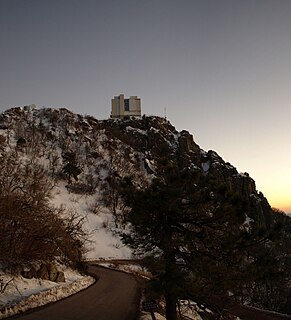
The MMT Observatory (MMTO) is an astronomical observatory on the site of Fred Lawrence Whipple Observatory. The Whipple observatory complex is located on Mount Hopkins, Arizona, US in the Santa Rita Mountains. The observatory is operated by the University of Arizona and the Smithsonian Institution, and has a visitor center in nearby Amado, Arizona. The MMTO is the home of the MMT, which has a primary mirror 6.5 m in diameter. The name comes from the six smaller mirrors originally used before the single primary mirror was installed in 1998. The primary mirror has a special lightweight honeycomb design made by the University of Arizona's Steward Observatory Mirror Laboratory. The MMT is housed in a building which allows the walls and roof around the telescope to be completely rolled back, allowing it to cool down very quickly in order to improve observation.
The Gregorian telescope is a type of reflecting telescope designed by Scottish mathematician and astronomer James Gregory in the 17th century, and first built in 1673 by Robert Hooke. James Gregory was a contemporary of Isaac Newton. Both often worked simultaneously on similar projects. Gregory's design was published in 1663 and pre-dates the first practical reflecting telescope, the Newtonian telescope, built by Sir Isaac Newton in 1668. However, Gregory's design was only a theoretical description, and he never actually constructed the telescope. It was not successfully built until five years after Newton's first reflecting telescope.

A segmented mirror is an array of smaller mirrors designed to act as segments of a single large curved mirror. The segments can be either spherical or asymmetric. They are used as objectives for large reflecting telescopes. To function, all the mirror segments have to be polished to a precise shape and actively aligned by a computer-controlled active optics system using actuators built into the mirror support cell. The concept and necessary technologies were initially developed under the leadership of Dr. Jerry Nelson at the Lawrence Berkeley National Laboratory and University of California during the 1980sThis claim is incorrect, see discussion., and have since spread worldwide to the point that essentially all future large optical telescopes plan to use segmented mirrors.

A telescope is an optical instrument using lenses, curved mirrors, or a combination of both to observe distant objects, or various devices used to observe distant objects by their emission, absorption, or reflection of electromagnetic radiation. The first known practical telescopes were refracting telescopes with glass lenses and were invented in the Netherlands at the beginning of the 17th century. They were used for both terrestrial applications and astronomy.
PLate OPtimizer, or PLOP is a CAD program used by amateur telescope makers to design primary mirror support cells for reflecting telescopes. It was developed by telescope maker David Lewis, first described in 1999, and used to simplify calculations needed in the design of mirror support cells. It was based on Toshimi Taki's 1993 program PLATE, with a simplified user interface, thus giving it wide acceptance among makers of large Dobsonian style amateur telescopes, with good support of mirrors as thin as two inches for a diameter of thirty inches.

The Linden Observatory Complex is a heritage-listed former observatory and manufacture of optical precision implements and now residence, museum, observatory, education facility and meeting venue located at 91 – 111 Glossop Road, Linden, City of Blue Mountains, New South Wales, Australia. It was designed and built by Ken Beames from 1938 to 1948. It is also known as K Beames Engineering Co. The property is owned by the Linden Observatory Trust. It was added to the New South Wales State Heritage Register on 5 March 2010.
